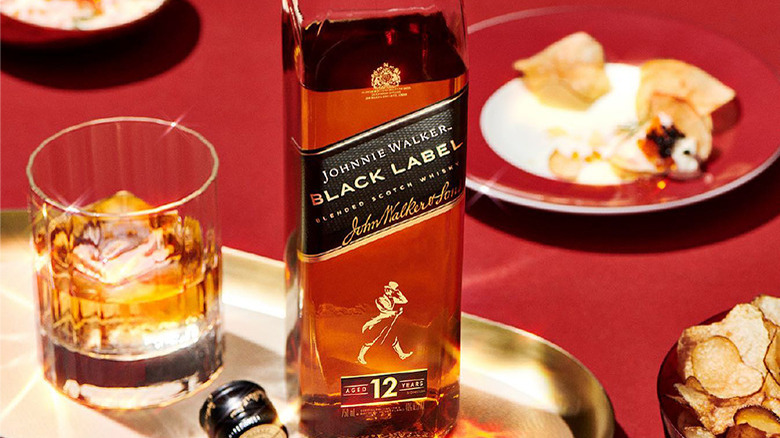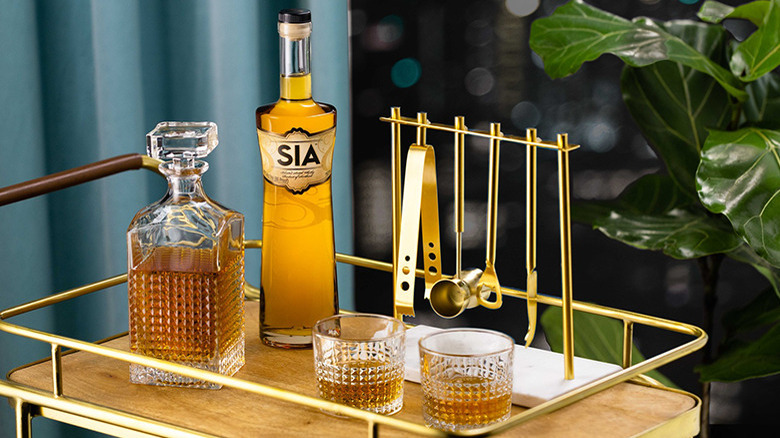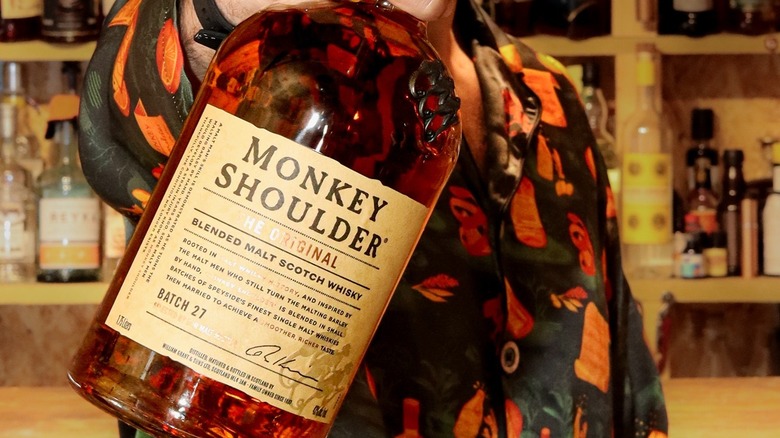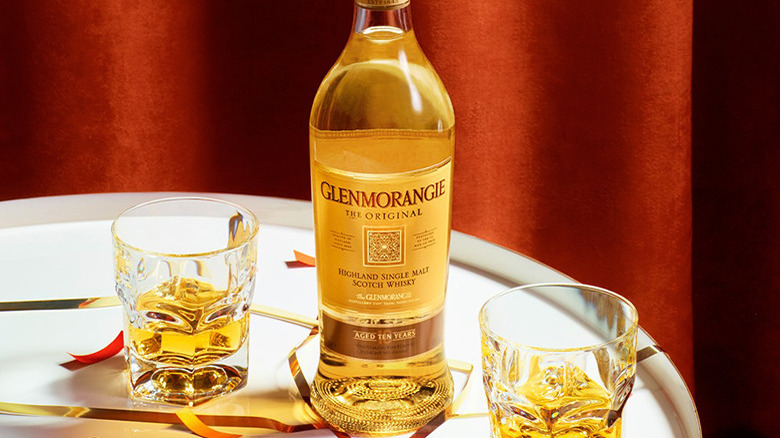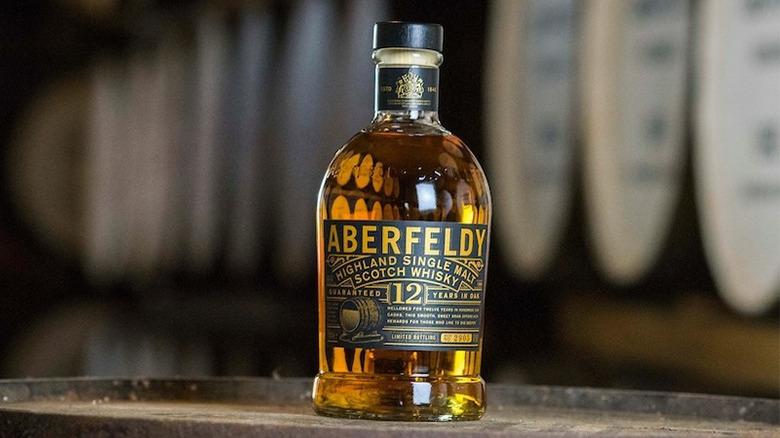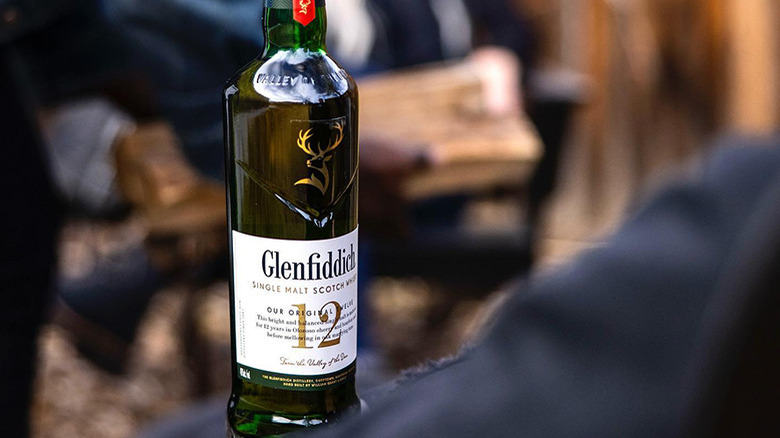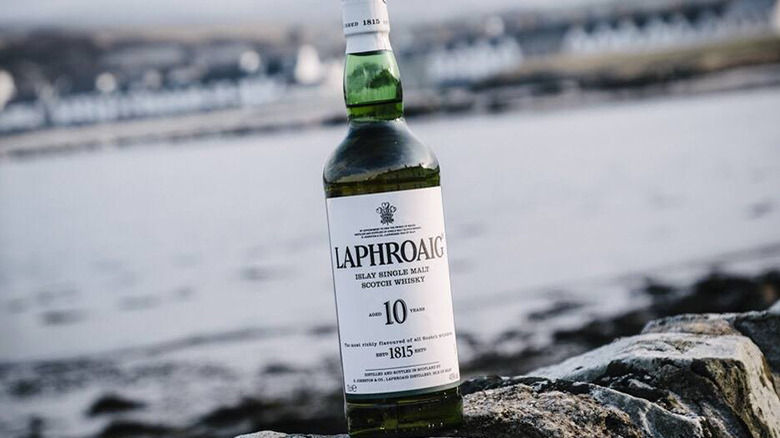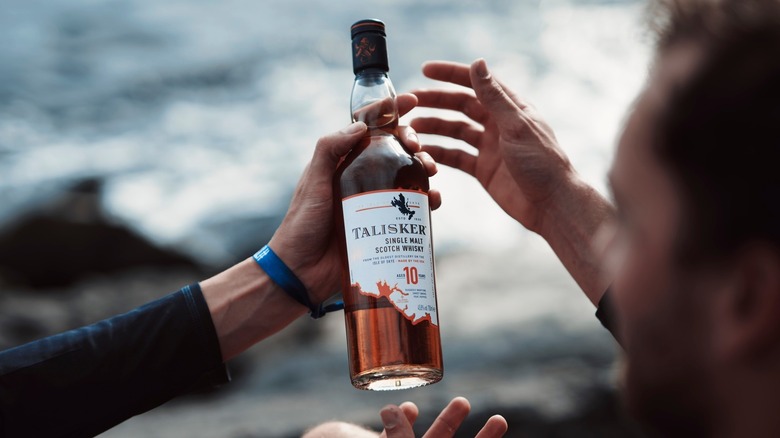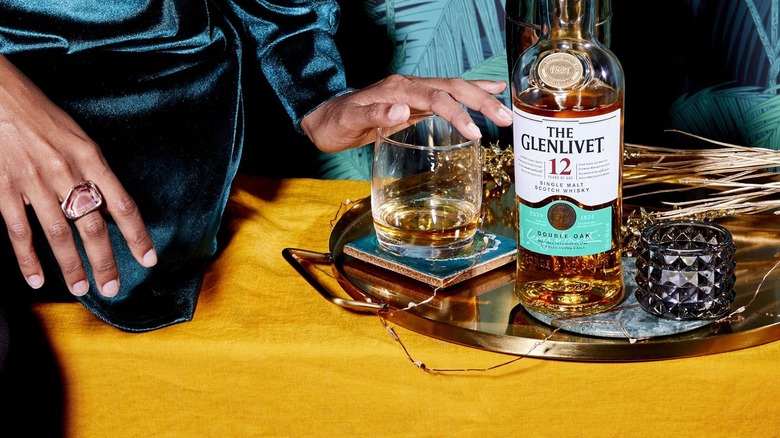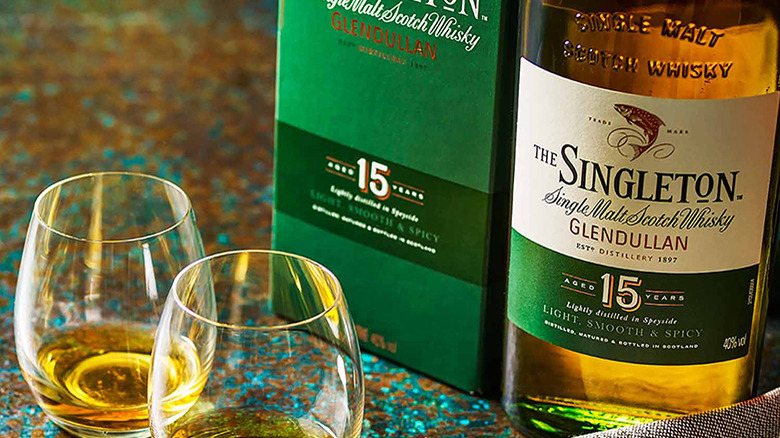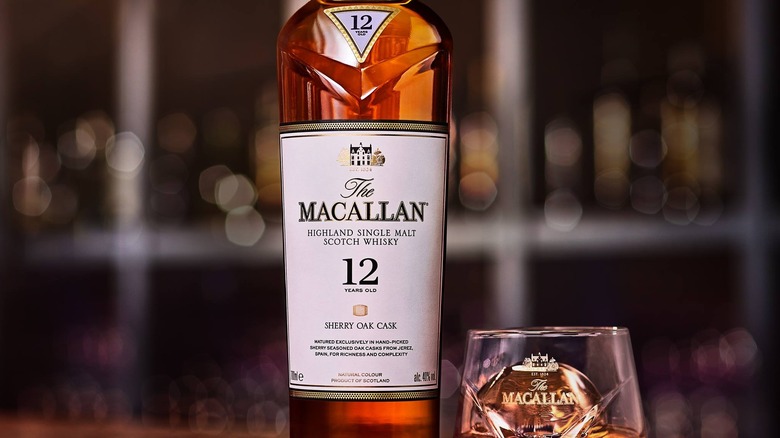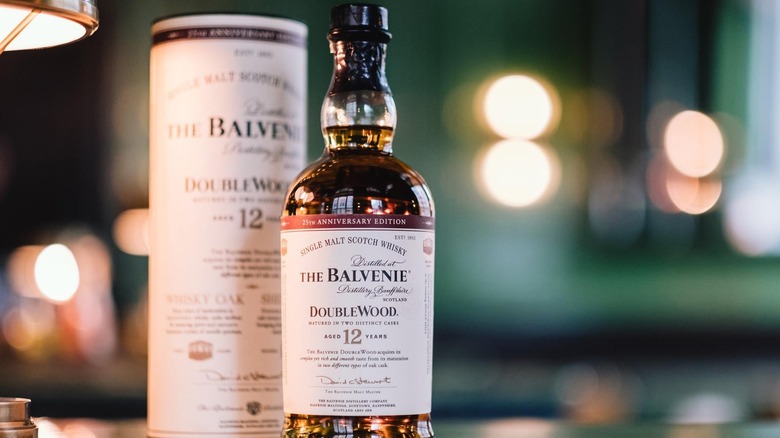12 Bottles Of Scotch For Beginners
Getting into scotch can be overwhelming. There are so many variables to consider from different styles to where they come to a price that those unfamiliar may tend to just avoid the spirit entirely. In reality, however, there is a scotch out there for everyone, and developing your palate for scotch and finding some personal favorites is more accessible than you might think.
First of all, expensive scotch does not automatically mean good scotch. There are plenty of great scotch whiskies available at an affordable price point, as well as expensive ones that are more of a risky investment than a reliable one. Furthermore, scotch whisky is broken into categories of single-malt, single-grain, blended scotch, blended malt, and blended grain. Differentiating them may seem difficult at first, but with more exposure, you will figure out what you like and don't like.
Scotches also vary based on where they are made. The regions of scotch are broken down into Lowland, Highland, Speyside, Islay, and Campbeltown, of which correspond to different brands, characteristics, and production methods (more on that later). Most importantly, how you enjoy scotch is entirely up to your preferences, so do not get caught up in whether to sip it neat, from certain glassware, or whatever so-called connoisseurs say is correct. With this foundation of scotch knowledge, here are some bottles that can be your access point to the wide and wonderful world of scotch whisky.
Johnnie Walker Black Label
Even if you have never bought a bottle of scotch, you have heard of Johnnie Walker. It is probably the most iconic brand of all. Of all of the bottles in its lineup that have come and gone, Black Label has always been a signature expression and is perhaps the most base-level scotch on the entire market.
All of Johnnie Walker's core whiskies are blended whiskies, made up of scotches from across Scotland. Black Label is a 12-year blended whisky, meaning the youngest whisky that goes into the blend is aged for at least 12 years, and this particular blend is made up of single-grain and single-malt whiskies. Single-grain whiskies can be made using any type of grain and are often softer, more delicate, and in the case of Black Label, help to balance out the robust character of the single malts. Single-malt scotches can only be made from one type of malted barley, have a bolder character, and are typically more expensive.
Despite the long-lasting international success of Black Label, it remains a very affordable bottle at an average of $39. If you are hesitant to make the investment, you can try Black Label at virtually any bar. What you will find is a timeless, well-balanced blended scotch that will give you a perfect reference point for what scotch whisky generally is.
SIA Scotch Whisky
SIA Scotch Whisky is another blended scotch and is one of the only woman-owned brands on the market, founded by Carin Luna-Ostaseki in 2013. Upon being introduced to the spirit, she noticed how extensive and inaccessible scotch was for newcomers, so she set out to make one that was a straightforward introduction.
The blend that makes up SIA is made from scotches of the Highland, Lowland, Islay, and Speyside regions. This harmonious balance gives you a little bit of everything, with subtle notes coming through that represent each region. It is aged in two different oak barrels, one a refill ex-bourbon cask and the other a first-fill American oak cask.
Another key factor behind SIA's creation is that getting into scotch should not be expensive, and a bottle of SIA Scotch Whisky costs an average of $40. If you are still concerned about investing in a bottle and having it not be to your liking, SIA has the recognition to back it up. It was awarded Double Gold in the San Francisco World Spirits Competition as well as a 96-point rating in its category by the Ultimate Spirits Challenge, notes the brand's site. Plus, if sipping it straight turns out to not be your thing, SIA is well-suited for mixing into cocktails due to its balanced blend.
Monkey Shoulder
Speaking of scotch cocktails, this next scotch was made specifically for mixing. Although it is made at a distillery that has been making scotch for over a century, Monkey Shoulder did not come about until the early 2000s. The idea behind this newer brand of scotch is the perfect encapsulation of what enjoying the spirit is supposed to be about, that is, doing so the best way you know how.
Scotch snobs shout all sorts of pompous declarations regarding which scotch style is best and how you are supposed to drink it, but if you enjoy drinking the spirit a certain way, that is all that matters. This is why some drinkers are scared of scotch because there seems to be so much pressure about what is right and wrong. All in all, if you enjoy it, you are doing it right.
Monkey Shoulder is great for mixing because it carries a variety of aromas and flavor notes found in different types of scotch from different parts of the country. This whisky is bright and citrusy, warming with notes of honey, and subtly spiced by its barrel notes. You obviously do not have to use Monkey Shoulder as a mixer, as you can discover a variety of typical scotch characteristics by sipping it straight. However you choose to try it out, Monkey Shoulder will open your palate to new discoveries, and it will only cost you an average of $33.
Glenmorangie Original 10-Year
If you have already been exposed to blended scotch or you are eager to dive right into single-malts, Glenmorangie Original 10-Year is one of the best places to start. Glenmorangie has been making scotch since 1843, and its original 10-year-old expression remains its signature bottle and one of the quintessential introductions to Highland scotch whisky.
As mentioned earlier, there are multiple qualifications that distinguish a single-malt scotch. They must be made from only one type of malted barley, distilled in copper stills, and produced entirely at one single distillery. Single-malt scotches are widely considered to be the most high-end version of the spirit. However, Glenmorangie Original 10-Year remains a very affordable, reliable option at an average of $41.
This scotch is sure to dispel any preconceived notions of scotch being a harsh, brawny spirit that shoos away delicate, inexperienced palates. The Highland category of scotch is very diverse, as it is the largest region, but while not all Highland scotch tastes the same, these whiskies are generally fruitier and more elegant. Glenmorangie Original 10-Year is a perfect example of this, as its bright character is ripe with notes of honey, citrus, and vanilla from the bourbon cask maturation. It is a well-rounded whisky that is not only a gentle introduction to single-malt and Highland scotch but also one that will help you start to recognize certain flavor notes and characteristics to keep in mind going forward.
Aberfeldy 12-Year
Aberfeldy 12-Year is another Highland scotch whisky that provides many different flavor notes and a depth of character in a very simple way. This scotch is a great example of what is possible by doing simple things really well.
Aberfeldy makes its scotch whiskies at its distillery in the Central Highlands and has access to its very own water source. It also ferments its mash longer than other distillers, which intensifies its flavor. Aberfeldy's 12-year-old expression spends its maturation in ex-sherry, ex-bourbon, refill, and re-char casks, the combination of which makes for a whisky bountiful and robust in flavor and silky smooth in every sip. The act of charring aging barrels is done to open up the fibers of the wood so the whisky can penetrate it more deeply, therefore taking on more of its character. Another reason is to impart an extra laid of the flavor of charred goodness.
This is especially effective and present in the Aberfeldy 12-Year. This whisky has everything you love about a classic Highland single-malt, only more potent. The deep honey sweetness, vibrant citrus notes, and well-rounded malt are all supported and elongated by a subtle smokiness from the re-charred casks. A bottle of Aberfeldy-12 Year costs an average of just $44, so if you are ready or curious about Highland single-malts, one of this age, complexity, and price point is a no-brainer.
Glenfiddich 12-Year
Being apprehensive about committing to a whole bottle of scotch is understandable. Putting down the money for something you may or may not like is not always the wisest decision, but if you want to taste the most fundamental, straightforward Highland single-malt scotches, you should be looking for Glenfiddich 12-Year.
The distillery dates all the way back to the 1880s and was built by hand by its founder. Since then, its flagship bottle, Glenfiddich 12-Year has become the world's best-selling single-malt scotch, as of 2017, per Scotch Whisky. The accomplishment is more than justifiable, as the craft that goes into Glenfiddich 12-Year makes it no gimmick. This whiskey is made using a water source that is private to the distillery, the same exact water that it has used for over a century. The scotch is aged in traditional oak that embellishes that iconic Highland profile for a whisky that is bold and rounded but still soft, malty, and warm.
A bottle of Glenfiddich 12-Year can be purchased for an average price of $47, so if you are eager to jump right into the classics, there may be no better place to start than with this bottle. Glenfiddich 12-Year has sustained as a leader in its class for decades as a straightforward expression of what a well-aged, Highland single-malt is supposed to be, and just one sip will prove it right.
Laphroaig 10-Year
For this next scotch, we move to the Islay region. This may be the smallest, but it definitely packs the biggest punch. Islay scotches are known for their peat, a term attributable to whiskies of other regions, but most common in Islay.
Peated scotches are made by cutting peat, which is essentially bog, from peat beds, drying it out, and then burning it underneath the mash. This infuses its flavor and aromas into the mash above, which is what makes peated scotch taste smoky, earthy, briny, and peaty, depending on the character of the peat itself. Peat is admittedly a polarizing quality in scotch, so it may not the best choice for your first sip. However, once you develop a taste for the spirit, peated scotch is a must-try, and there is none more classic than Laphroaig 10-Year.
Laphroaig has been distilling its iconic scotch since 1815 and has since been one of the most iconic distilleries from the isle of Islay. Laphroaig 10-year is its flagship bottle, and this scotch is the epitome of one that will "put some hair on your chest." Its peat is robust and rich with smoke, brine, and even medicinal flavor notes. Again, it may not be the best first sip of scotch, but in the realm of Islay and peated whisky, Laphroaig 10-Year is the most fundamental. This scotch is also one of the more affordable Islay scotches on the market, costing an average of $58.
Talisker 10-Year
If an intensely peaty scotch is not something you think you would like, a more subtle and approachable expression of the style is Talisker 10-Year. The Talisker distillery is located on the Isle of Skye, which is technically part of the Highland region, but its location makes for a very unique and complex scotch whisky. Plus, at an average price of $62, it is on the more affordable side in its category (if you haven't caught on by now, scotch can get pretty pricey).
Everything that goes into a whisky makes a difference and this includes geography, no matter how specific. In regards to Talisker, its coastal environment affects the peat, barley, and overall character of the scotch. The peat is briny and salty from the sea, while the malt that grows there is sweet and fruity. This makes for a very layered scotch that is more mellow than a peated whisky like Laphroaig.
Talisker 10-Year is ideal for a more cordial welcome to peated whiskey. The sweet honey and lush malt pave the way for the peat and smoke to remain in the background as supporting notes, instead of overpowering ones. You can dive straight into peated whiskey with a bottle like Laphroaig, or you can approach it slowly, but surely, with Talisker 10-Year.
Glenlivet 12-Year
Glenlivet is one of the most iconic brands of scotch on the market, and its signature 12-year-old expression is another bottle that can most likely be found at any bar that sells whisky. Glenlivet 12-Year is a single-malt, Speyside scotch, a regional category made up of whiskies produced in the area of Scotland surrounding the River Spey. This sector of scotch is especially great for beginners because most Speyside whiskies have very little peat or no peat whatsoever. They are generally fruity, very soft, and smooth.
In regards to Glenlivet, the distillery is located in the Livet Valley, beautifully tucked away in the midst of stunning scenery, a terrain that contributes to as tranquil a whiskey as the water running through it. At 40% ABV and after 12 years spent in traditional and American oak, this whiskey is malt-forward with a centric flavor of vanilla and caramel. Even for a scotch beginner trying the spirit neat, there is no need to worry about any alcoholic burn. If this is the first scotch whisky you try, it may shock you how smooth scotch could be.
Another notable factor in Glenlivet 12-Year is that is more than affordable. Considering its age statement and double oak maturation, getting a bottle at an average cost of $50 is best described as a steal. Again, you can easily try this scotch at a bar before you commit to buying a whole bottle, but making the investment will certainly pay off.
The Singleton 15-Year
The Singleton is another younger brand of scotch that only became available in the U.S. in 2006. The distillery that produces The Singleton, however, is a formidable piece of scotch-making history. The whisky is made at the Glendullan distillery, founded all the way back in 1897. The Singleton offers three different expressions, a 12-year-old, 15-year-old, and 18-year-old. Given the rarely accessible price point for its age, the 15-year is your best bet if you're just getting started.
As a Speyside whisky, you can expect any bottle by The Singleton to be light, fruity, and delicate like its interregional counterparts. The reason why the 15-Year is recommended, however, is because it will allow you to discover the difference a whisky's age makes without having to break the bank. While other 15-year-old scotches come in at more exorbitant prices, The Singleton 15-Year is available at an average price of just $56.
The Singleton 15-Year is a great starter scotch for reasons beyond its price, though. This mighty fine whisky is complex and layered but still very approachable. It is aged mostly in American oak, with a small amount of tiny spent in European oak for some added depth. This whisky is zesty with citrus and pepper notes from the combined maturation, and its single-malt keeps everything straightforward and balanced. Although its age statement may draw discouragement from purists, this scotch is also great for cocktails due to its bright character and roundness.
The Macallan 12-Year Sherry Oak
This next bottle of scotch is a great way to broaden your palate in terms of understanding how different types of wood contribute to different flavor profiles. The Macallan is one of the most renowned and celebrated scotch brands, and its 12-Year scotch matured in Sherry-seasoned casks is one of its more unique expressions. This particular scotch is a Highland single-malt, and its 12 years spent in Sherry casks make for a very nuanced and complex whisky that will introduce you to a whole new way to classify the spirit.
The Macallan takes its casks very seriously. In fact, the distillery employs its own "Master of Wood." His name is Stuart MacPherson and he is in charge of selecting the best casks for aging all of The Macallan's whiskies. For this particular one, MacPherson oversees the cask from its selection in Jerez, Spain.
The sherry casks used to mature this scotch impart dry fruity notes, an excellent compliment to the soft Highland malt. The Macallan lineup is more expensive than most, and its 12-Year Sherry Oak comes in at $96 on average. This is definitely more expensive than other beginner scotches on this list, but the length at which this excellent whisky will broaden your perspective will be worth it in the long run.
The Balvenie 12-Year Double Wood
To expand for palate for wood-aging even further, The Balvenie 12-Year Double Wood is an excellent and more affordable way to do so. The Balvenie has been distilling and aging amazing whiskies for a very long time, since 1892 to be exact, and is another distillery that has always taken its wood very seriously.
This whisky was first made in the early 1990s and was thought up and handcrafted by the distillery's Master of Malt, David Stewart, one of the pioneers of what is now the common practice of wood finishing. This 12-year expression from The Balvenie is aged for 12 years in traditional and American oak casks before being transferred to Oloroso Sherry casks for nine months. After maturation, the whiskey is combined with other whiskies for several additional months, known as the marrying period. The result is a scotch whisky so layered and complex, it will make you reconsider how consequential wood and maturation are.
The Balvenie 12-Year Double Oak is fruity and spiced from the sherry casks, and familiar and rich from the traditional oak. The usual notes of soft, sweet honey typical in a Highland single-malt are enhanced by the unique sherry notes. The double cask maturation makes it perfectly balanced, and at an average of $71, a whisky this special and well-made is nothing short of a bargain.

